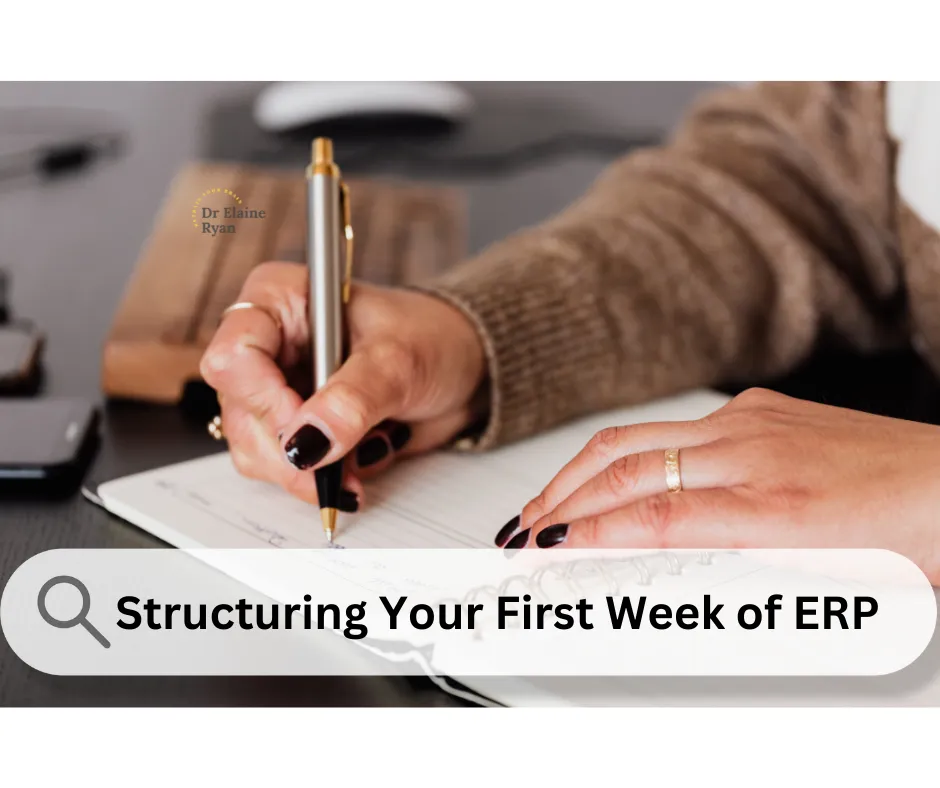This guide is designed for anyone starting off with ERP; Exposure and Response Prevention—whether you’re already working with myself, another ERP therapist or trying self-help, I want to include some self-help tips in this article to ensure you are successful. In these self help articles, indeed on my entire website, I am trying to bring the help and expertise that you get in session onto the written word. People often fail in ERP, or any therapy for that matter, as they were not told how to navigate the therapeutic bumps in the road and in this article I want to help you get ready for your first week doing ERP. I’m not going to discuss the model in detail as you can read my Guide to ERP here; rather I am just going to jump in with what you need to do to help yourself successfully negotiate your first week of exposures.

Dr Ryan’s Online Structured Therapy for OCD
Before You Begin: Setting the Stage for Quick Wins
I really want you to get the best out of ERP and it has come to my attention that not many people offer ERP therapy in Ireland, so I shall put more self-help material on my sit as research consistently shows that it is considered the most effective treatment for OCD.
1. Identify Your Triggers and Define Quick Wins
- List Your Triggers: Write down situations or thoughts that trigger anxiety or compulsions.
- Rank Them: Order these triggers from “low anxiety” (e.g., 3/10) to “high anxiety” (e.g., 10/10).
- Select a Quick Win: Choose one trigger from the lower end of your scale—a task that’s challenging enough to promote progress but not so overwhelming that you risk shutting down.
2. Establish a Baseline
- Set an Anxiety Scale: Create a simple scale from 1 to 10. Rate your anxiety before, during, and after each exposure.
- Journal Format: Prepare a daily log with fields for “Trigger,” “Pre-Exposure Anxiety,” “Post-Exposure Anxiety,” and “Reflections/Successes.”
Your 7-Day Action Plan for ERP Quick Wins
Each day builds on the previous one, gradually increasing your comfort with facing anxiety while learning valuable coping strategies. When I say each day builds on the previous one, it is extremely important that you start with a successful day, so before I go any further, I want to tell you how to measure success. Success is not doing an exposure with no compulsions, although let me say if you do that it is incredible but highly unlikely, so let me tell you what success is. Keep in mind, I’m a psychologist doing this for a very long time so even if what I am about to say, doesn’t sound like a success to you just run with it as I know I keep repeating this, but it is incredibly important. You need to start your first day with a success; with a win. So success can be any of these things for example,
- attempting the exposure is a success
- thinking about how you are going to do, the exposure is a success
Basically what I’m trying to say, and this is what I would say to you if you were in session with me now as a client, is that you cannot fail. The only way you can fail this is not making any attempt to do an exposure and even then I am sure if I talked with you, we will find reasons why you are not able to start an exposure that day and I would not consider it a failure. If there’s any attempt, you have to pat yourself on the back and tell yourself that it was a success because you won’t need me to tell you this, but starting ERP can be difficult so any attempt is a success. Now I will get on with what I want to talk about in this article.
Day 1: Laying the Groundwork
- Morning:
- Define Your Quick Win: Select a low-intensity trigger from your list. For example, if your fear is contamination, choose something like touching a common door handle. Learn more about contamination OCD.
- Write Down Your Goal: “Today, I will touch the door handle and refrain from immediately washing my hands.” If you are working with another therapist, and they haven’t told you, there is some wiggle room with this. It could be I won’t wash my hands for 5 minutes, or I will just wash as far as my wrists.
- Afternoon:
- Self-Assessment: Record your anticipated anxiety level on your 1–10 scale.
- Reflection Journal: Write a brief note on your feelings about starting ERP.
In my private practice, clients who start with a well-defined, low-risk exposure tend to experience immediate relief—even if the anxiety is present at first. Recognizing even a slight reduction in anxiety is a win.
Day 2: Planning Your Exposure
- Morning:
- Detail Your Strategy: Map out exactly how you will perform your exposure. Include time, location, and any supportive tools (e.g., a timer, deep-breathing exercises).
- Afternoon:
- Visualise Success: Spend 10 minutes in a quiet place visualising yourself successfully handling the exposure. Don’t skip this part, as during visualisation you can feel the associated fear or anxiety, and practice calming yourself down, instead of carrying out a compulsion.
- Evening:
- Do a short relaxation exercise (like a guided meditation from an app, if you don’t have one, try the free version of Headspace)
Day 3: Your First Exposure
- Morning:
- Follow your plan—perform your selected exposure (e.g., touch the door handle). Focus on staying in the situation for at least 5 minutes, even if anxiety begins to rise. Having a plan is crucial at this stage. We (humans) are not great with change, especially if we know it is going to frighten us or make us anxious, as our default is not avoid it or run away from it. Having a plan, where you tell yourself not to think about it, just follow the steps, helps immensely. I used this approach myself when I gave up smoking many years ago, I just followed what I had written down even though my cravings and anxiety were sky high.
- Record Your Experience: Immediately after, note your anxiety level (pre-, during, and post-exposure) in a notebook or worksheet.
- Evening:
- Write down one or two things that went well. Even if you felt anxious, staying in the exposure is a significant win.
Day 4: Strengthening Coping Skills
- Morning:
- Review: Look over yesterday’s work. Identify specific moments when your anxiety peaked.
- Afternoon:
- Practice a short session of deep breathing, progressive muscle relaxation, or grounding exercises when you anticipate a rise in anxiety. Each time you do this, what you are actually doing is practising inducing the relaxation response and this is what you need to be able to do during exposures.
- Evening:
- Write about which techniques felt most effective. Note any differences in your anxiety levels compared to Day 3.
Recognising that discomfort is part of the process is key. Being able to sit with discomfort, or practice a relaxation skill is half the battle of ERP.
Day 5: Reflection and Reinforcement
- Morning:
- Read through your worksheets or notes from Days 1–4. Identify common triggers and successful coping strategies
- Evening:
- Adjust Your Plan: If you feel ready, consider tweaking your exposure plan for the next day. If not, focus on consolidating your gains.
Day 6: Increasing the Exposures Gradually
- Morning:
- Pick a slightly more challenging trigger from your hierarchy. For example, if touching a door handle was your first step, consider touching multiple door handles in different settings.
- Afternoon:
- As you perform the exposure, actively employ the coping skills you practiced on Day 4. Remember when I said above that when you practise relaxation exercises, it is to help with this.
- Evening:
- Record your anxiety levels and note any differences in how you handled the increased challenge. Did your coping techniques make the new exposure feel more manageable?
Day 7: Consolidation and Planning Forward
- Morning:
- Look back at your progress over the week. Identify your biggest wins and any areas where you still feel challenged.
- Afternoon:
- Based on your week’s experiences, update your trigger hierarchy. Define next steps for gradually tackling higher-anxiety situations.
- Evening:
- Acknowledge your commitment and progress—perhaps treat yourself to something enjoyable. Try not to skip that bit. When I mentioned above that I followed a strict plan when I stopped smoking, I included treats at the end of milestones, and this really did encourage me.
Dr Ryan’s Structure Therapy for OCD
If you would like more help my self-help course provides expert guidance based on ERP and CBT and costs €89 or book a session for psychological therapy.
Remember, while this guide offers practical steps for quick wins, ERP is a process that might benefit from personalised support. I specialise in Exposure and Response Prevention (ERP), a targeted, evidence-based form of Cognitive Behavioral Therapy (CBT) specifically designed for treating OCD. This focused approach allows me to help you overcome compulsions and anxiety effectively. With over 20 years of professional experience dedicated to OCD and Anxiety Disorders, I’m available for consultations.
